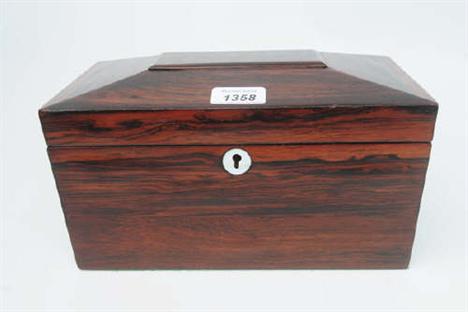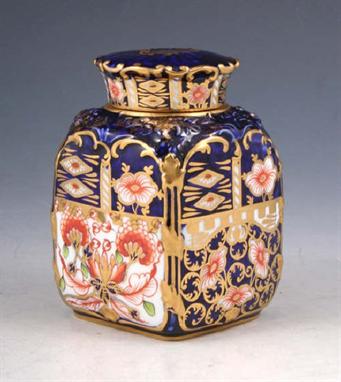We found 81455 price guide item(s) matching your search
There are 81455 lots that match your search criteria. Subscribe now to get instant access to the full price guide service.
Click here to subscribe- List
- Grid
-
81455 item(s)/page
A silver rectangular vesta case, with engraved decoration, Sheffield 1904, a silver napkin ring, with engine turned decoration, Birmingham 1937, a silver caddy spoon, designed as the Coronation Anointing Spoon, London 1902, a spoon with pierced scrolling decoration and an Oriental waist belt.
A quantity of metal ware collectables including; copper plaque embossed with Art Nouveau decoration, Arts and Crafts copper ashtray, two copper wall pockets, copper tea caddy with beaten finish, copper Arts and Crafts wall plaque embossed with fish and boats, Arts and Crafts coal bin and sundry.
A Victorian mahogany physician’s portable apothecary cabinet Unsigned, mid 19th century With brass top handle to the caddy moulded exterior, the front with two hinged sections fitted with two tiers of three glass bottles (two lacking), with four further larger bottles above two drawers with turned bone handles behind, (drawer contents incomplete), on moulded base, 26.5cm high.
A George III inlaid mahogany bulb cistern tube mercury stick barometer P. Stillo, Manchester, early 19th century The rectangular silvered vernier register calibrated in inches with Fahrenheit scale mercury thermometer and signed P. Stillo N.4 Thomas Street, Manchester behind glazed door beneath broken pediment, with caddy moulded and line inlaid trunk with domed cistern cover to the circular base, 97cm high.
A French ebony and brass Religieuse style bracket clock Unsigned, late 19th century, probably incorporating earlier components The eight-day two-train movement rack striking the hours on a bell mounted within the caddy above, with 10.5 x 6 inch blue velvet covered dial applied with brass Roman numeral chapter ring with every minute numbered above foliate festoon swag and scroll cast mount, the caddy-top case with flambeau finials and gilt balustrade frets above Corinthian pilasters to the brass line inlaid front and conforming arch glazed sides, on moulded base with lambrequin panel to apron and on brass ball feet, some damage and losses to case, 53cm high overall.
A William & Mary ebony veneered bracket clock James Mitchell, London, circa 1695 and later The five (formerly six) finned pillar twin fusee movement with backplate engraved with a dolphin amongst flowering foliage and herringbone border, now with later anchor escapement and chiming the quarters on four bells, and with internal rack for the hour strike on a further bell, the 8 inch x 7 inch rectangular brass dial with foliate engraved calendar aperture, ringed winding holes and false bob . Aperture to the matted centre within an applied silvered Roman numeral chapter ring with cruciform half hour markers and Arabic five minutes, the angles with winged cherub head spandrels beneath signature James Mitchell, London within engraved foliate scrolls to upper edge of dial, the ebony veneered case with gilt foliate cast handle to the caddy top above horizontal sound frets and rectangular windows to sides, on moulded base, movement with alterations, case with restorations, 38cm high excluding handle.
A William III walnut and arabesque marquetry eight-day longcase clock Peter Garon, London, circa 1700. The five finned pillar (centre latched) outside countwheel bell-striking movement with 12 inch square brass dial with scroll engraved calendar aperture, subsidiary seconds dial and ringed winding holes to the matted centre, within an applied silvered Roman numeral chapter ring with Arabic five minutes, stylised sword hilt half hour markers and signed Peter Garon, London to lower edge, the angles with twin cherub and crown cast spandrels within a herringbone border to edge, the case with foliate fret to the moulded entablature above scroll inlaid hood door with integral columns, the trunk with decorated throat moulding above rectangular lenticle centred trunk door profusely inlaid with scrolling foliage and strapwork within conforming surround, the plinth with ogee top moulding and conforming marquetry panel within laurel border, on moulded skirt base, 216cm high. Peter Garon is recorded in Baillie, G.H. Watchmakers & Clockmakers of the World as being admitted to the Clockmakers Company in 1687. He worked firstly from St Bartholomew’s Lane and later St Giles, Cripplegate and was declared bankrupt in 1709. Two clocks of the same marquetry pattern are illustrated in Bruton, Eric The Wetherfield Collection of Clocks page 165 (Joseph Windmills) and 179 (Jonathan Lowndes). Both of these examples have caddy upstands, however the construction of the hood and profile of the cornice mouldings suggests that the current Lot was supplied in its current form.
A George II stained oak and pine eight-day longcase clock Thomas Hill, London, circa 1750. The five-pillar rack and bell striking movement with 12 inch brass break-arch dial with calendar aperture, subsidiary seconds dial and signed Thomas Hill, London to an applied shaped plaque to the matted centre, within an applied Roman numeral chapter ring with Arabic five minutes, the angles applied with Indian mask and scroll cast spandrels beneath STRIKE/SILENT dial flanked by dolphin mounts to arch, the case with domed caddy above moulded cornice, blind fretwork infill and integral pilasters to hood, break-arch trunk door and on reduced plinth base with moulded skirt, case formerly japanned, 232cm high.
A rare George II red japanned eight-day longcase clock Joseph Herring, London, circa 1750 The five-pillar rack and bell striking movement with 12 inch brass break-arch dial with subsidiary seconds dial and calendar aperture to the matted centre, within an applied silvered Roman numeral chapter ring with Arabic five minutes and twin bird and urn cast spandrels to angles beneath silvered boss signed Jos’h Herring, London flanked by dolphin cast mounts to arch, in a case with domed caddy and blind fret infill to the moulded stepped cornice above integral pilasters flanking gilt trail decorated hood door, the trunk with scallop shell and foliate painted throat moulding above break-arch door polychrome and raised gilt decorated with figures within an Oriental ornamental terrace landscape with pagodas on a faded red ground, the plinth further decorated with raised work of a courtier and attendants above stepped skirt, original decoration to case with wear and losses to finish, 229cm high. Joseph Herring is recorded in Baillie, G.H. Watchmakers & Clockmakers of the World as being Liveryman of the Clockmakers Company in 1767. It is possible that this clock was made either by Joseph earlier in his career (as a Freeman of the Clockmakers Company) or perhaps by Joshua Herring who worked from 1742 to 1763.
-
81455 item(s)/page







































